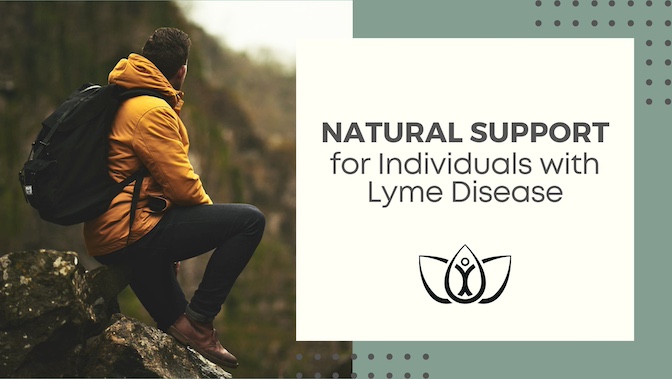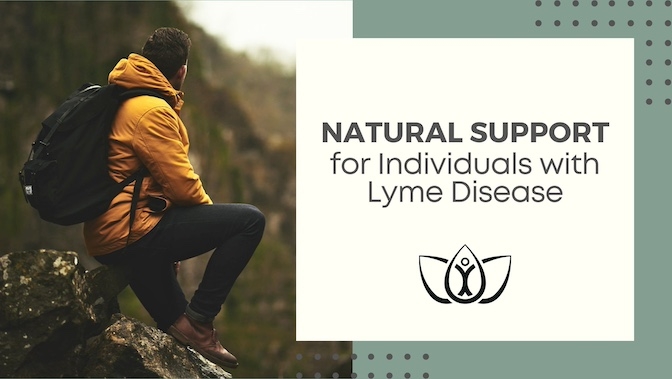This blog post was written by Trinity School of Natural Health and reviewed by Lauren Ameling, DC, BCND.
Being in nature can make you feel more connected and grounded, but it can also bring some significant problems. After all, nature has a wide range of elements, from fresh air and beautiful scenery to extreme weather and dangerous wildlife. Ticks are one common negative aspect of nature that can trigger havoc since some ticks can cause bacterial infections such as Lyme Disease.
Lyme disease is caused by the bacterium Borrelia burgdorferi, which can be transmitted through the bite of infected black-legged ticks that are commonly found in wooded and grassy areas. Lyme Disease symptoms vary from person to person but often include a red “bull’s eye” rash, fever, fatigue, muscle aches, and joint pain. If left untreated, Lyme Disease can lead to more severe complications such as arthritis, heart palpitations, and neurological problems.
One of the biggest challenges with Lyme disease is that it is difficult to diagnose due to its widespread and varied presentation. Unless a clear bull’s-eye rash appears on visible skin, Lyme Disease could go undetected since it mimics other illnesses. Doctors perform a physical examination and assess medical history, exposure risk, and laboratory tests to make the diagnosis. After Lyme Disease is confirmed, treatment typically includes antibiotics, which are most effective in the early stages of the bacterial infection. Therefore, prompt medical attention is important if Lyme Disease is suspected.
If you or a loved one have been diagnosed with Lyme Disease, you understand the complexity of this condition and the challenges that can arise. Read on to learn how to naturally support someone with Lyme disease and help prevent tick bites.
Natural Support for Individuals with Lyme Disease

For practitioners looking for solutions to support individuals with Lyme Disease, it’s important to consider their specific presentations and analyze their lifestyle choices, known as the Foundations of Health, before focusing on supplemental support. Also, inquiring about clients’ health history and how they’ve responded to any other care they’ve received for their current concerns is essential in making accurate and customized recommendations. This individualized approach is paramount in holistic healthcare. As with any medical condition, review recommendations with the diagnosing physician to ensure they are appropriate with the current treatment plan.
1. Diet
Although antibiotics are the primary treatment for Lyme Disease, natural methods can help support the healing process to alleviate symptoms and help the body recover after the course of antibiotics is complete. For example, the body benefits from added nourishment when recovering from a health challenge. Selecting whole foods, such as fruits, vegetables, nuts, and seeds, can help reduce inflammation and support the immune system to expedite recovery. Also, avoiding processed foods, sugar, and gluten are great ways to reduce inflammation and improve overall health. Additionally, incorporating food rich in antioxidants like berries, green tea, and dark leafy greens helps combat oxidative stress and support the body's natural detoxification processes. Finally, good bacteria in the body, known as probiotics, play active roles in human physiology, from digestion and immunity to brain function. Since antibiotics destroy both good and bad bacteria, it’s beneficial to take steps to repopulate the probiotics in the human microbiome. Some delicious sources of probiotics to include in your diet are yogurt, kefir, kombucha, miso, and fermented vegetables like sauerkraut and kimchi.
2. Supplementation
Beyond nutrition, supplements may be necessary when supporting individuals with health challenges like Lyme disease. As discussed in the Diet section, probiotics can help restore healthy gut bacteria, which is often compromised in individuals who receive antibiotics. Supplemental probiotics, commonly available in powdered drinks or capsules, are a simple way to get high doses of good bacteria if the foods mentioned above are not desired. In addition, omega-3 fatty acids naturally occurring in coldwater fatty fish like salmon, tuna, and sardines can be consumed through fish oil supplements to get the benefits of reduced inflammation and brain support without the taste or exposure to pollutants that come with eating this seafood. Other nutrients that may be more beneficial at supplemental levels for their roles in supporting the body's healing processes and helping alleviate symptoms associated with Lyme include vitamin D, magnesium, and Coenzyme Q10.
3. Lifestyle Changes
Lifestyle modifications are also helpful when supporting someone with Lyme. Since there is a direct correlation between stress and impaired healing, steps should be taken to rest during recovery. In addition, stress reduction techniques can reduce cortisol levels and support the immune system. Some stress reduction techniques to consider are journaling, prayer, meditation, and breathing exercises. It’s also crucial for individuals recovering from major illnesses like Lyme Disease to get adequate sleep to support the body’s natural ability to repair and regenerate itself. Lastly, walking, swimming, or other low-impact exercises can improve circulation, manage stress, and reduce inflammation while being gentle on the fatigued and achy body that’s common with Lyme Disease.
4. Alternative Therapies
Acupuncture, massage therapy, and herbal support are common complementary and alternative practices that can provide symptomatic relief and support healing in various acute and chronic illnesses. Acupuncture is an ancient healing art known to reduce pain and inflammation, improve circulation, and support the body's natural healing processes to improve overall health and vitality. Massage therapy can relieve muscle tension, improve lymphatic drainage, and promote relaxation, providing symptomatic relief and initiating positive changes for healing. Herbal remedies, such as Japanese knotweed, cat's claw, and garlic, have been shown to have antimicrobial properties and can help support the body's immune system in fighting off Lyme disease, while curcumin, the active component in turmeric, is a powerful anti-inflammatory and natural way to support a person with joint pain.
5. Mental and Emotional Support
The pain and frustration that come with illnesses like Lyme Disease are associated with a higher incidence of stress, anxiety, and depression. “Hidden” diseases, where the symptoms are not always evident to others, can be especially lonely and isolating. Couple these feelings with a presentation that can be unpredictable and debilitating, and people with Lyme Disease may find themselves feeling physically, mentally, and emotionally exhausted. Emotional support, encouragement, and understanding from loved ones can help individuals cope with their symptoms and stay positive during their recovery. Support groups or online communities are a great resource for connecting with others who are going through similar experiences. Not only do these groups help individuals be seen and feel heard, but members often share ideas to support physical health and well-being. When the road to recovery seems long, chronic disease can become especially challenging, so it may be wise to get help from a mental health professional, who can help individuals with Lyme Disease deal with the stress and emotions that can result from daily challenges as well as the initial shock of receiving the diagnosis.
Preventing Tick Bites
Regardless of previous exposure or current Lyme status, preventing tick bites is the best step to avoid tickborne infections. Therefore, taking precautions when spending time outdoors is essential, especially during the warmer months when ticks are more active.
Prohibiting ticks from reaching the skin is imperative. Light-colored clothing is recommended so that the dark ticks will be easier to spot, but any head covering, long sleeves, and pants tucked into closed-toed shoes will help when walking through wooded areas. In addition to this protective clothing, use insect repellent on exposed skin, remove and wash clothes when returning home, and check yourself for ticks while showering after spending time outdoors. Although the chemical tick-repellent DEET is commonly recommended, essential oil repellents containing lemon eucalyptus are effective, but they need to be reapplied more frequently. Some ticks are very small, making them difficult to spot, so thoroughly check areas such as the scalp, behind the ears, and in the armpits and groin where they could be easily hidden. If a tick is found and has latched on, grasp it as close to the skin as possible with tweezers and pull straight out. Monitor the bite for signs of infection and seek medical attention if any symptoms develop.
Preventative steps can also be taken to reduce the chance of encountering a tick in your yard. Keep grass and other plants trimmed, remove fallen leaves and brush, and create a barrier between woods and patios or play areas with gravel or wood chips. Additionally, spraying your yard with a lawn spray containing garlic oil is a natural way to help repel ticks.
Conclusion:
In conclusion, there are many ways to support individuals with Lyme Disease, but a comprehensive approach, including dietary adjustments, supplementation, lifestyle modifications, alternative therapies, and emotional support, is best. Addressing the individual’s needs to support the body's innate healing processes can improve both symptoms and overall well-being. Preventative measures are also vital in reducing the risk of tickborne illness.
For detailed information about Lyme Disease and how it affects health and vitality, consider taking our Certified Lyme Specialist program. Call 800-428-0408 or visit trinityschool.org/program/CLS to learn more and enroll.
References
https://www.webmd.com/skin-problems-and-treatments/what-to-know-natural-tick-repellents

